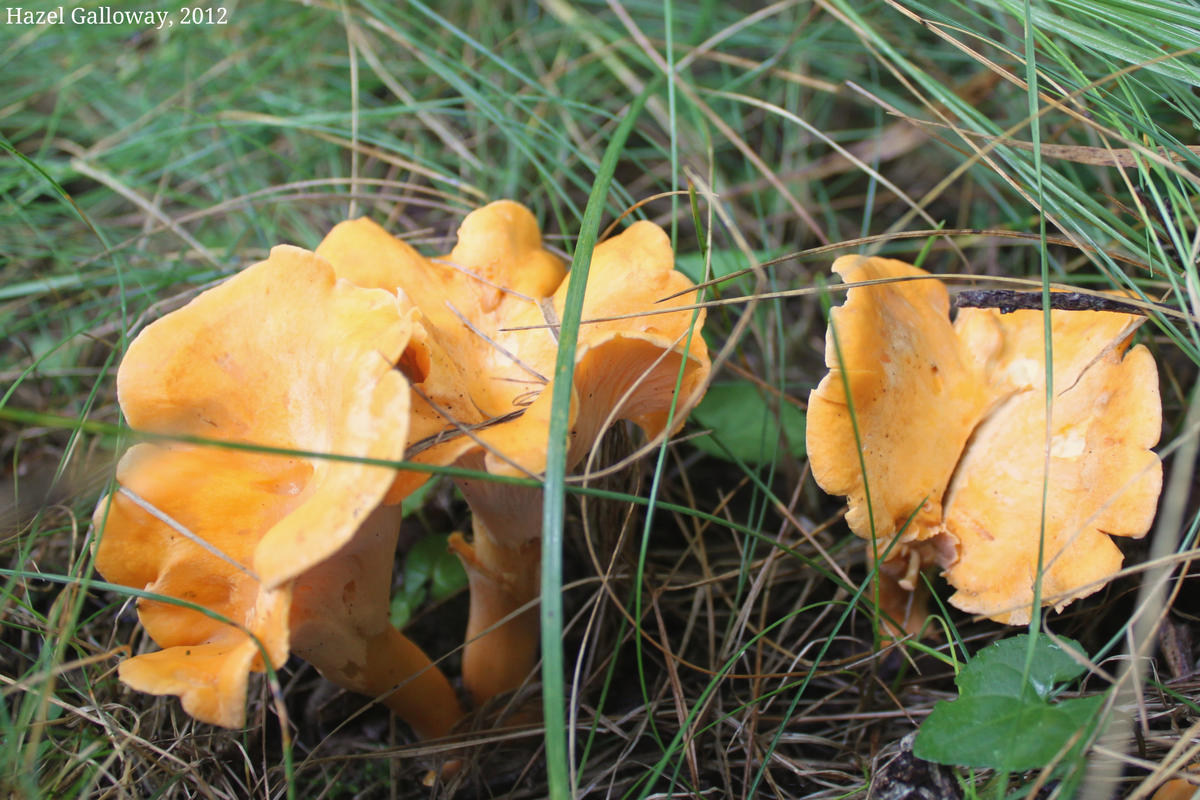Despite the vigorous warnings one will encounter in any mushroom guide—“don’t eat any mushroom unless you are absolutely sure of its identity!” or “when in doubt, throw it out!”—the family Cantharellaceae is, in fact, relatively benign. Except for one small group, all species of chanterelles are edible, and many are highly prized for their taste. 
Chanterelles, as a group, are relatively distinctive mushrooms. While many gilled mushrooms consist of a straight, centered stalk, a circular cap, and many thin and distinct gills covering the underside, chanterelles tend to be markedly irregular. A single, well-defined stem supports the vaguely funnel-shaped cap of C. lateritius, which has a rounded and irregular margin. Both the cap and the stalk are usually yellow-orange to pinkish-orange in color. However, the “gills” appear to be little more than small wrinkles in the underside of the cap. This is because, like most mushrooms in the family Cantharellaceae, they have false gills. In typical gilled mushrooms, the gills are structurally separate and distinct from the cap or stalk. However, in many chanterelles, the “gills” are nothing more than folds in the underside of the cap and stalk, which may closely resemble true gills. In the case of the smooth chanterelle, these folds have been reduced to small wrinkles or have disappeared entirely, accounting for its common name. Checking for the presence of false gills is one method of determining whether a certain mushroom is a true chanterelle—broadly, “true” chanterelles have false gills, while “false” chanterelles have true gills.
This species of chanterelle is widely distributed east of the Rocky Mountains. Often found growing on the floor of moist woodlands, it forms mycorrhizal relationships with oaks. In mycorrhizal relationships, the mycelium of the fungus (the permanent, underground portion of the fungus that exists even when no mushrooms are present) encloses tiny rootlets of the tree with microscopic “sheaths.” The mycelium helps the tree absorb water and nutrients, while the tree provides sugars and amino acids to the fungus in return. Although these symbiotic relationships are invisible, it is estimated that around 85% of plants depend on mycorrhizal relationships with different kinds of fungi. One can assume, therefore, that the number and size of visible mushrooms pales in comparison to the extent and pervasiveness of their underground mycelium. In fact, the mycelium of one single individual of the species Armillaria mellea (the honey mushroom) has been found across 2,200 acres and is estimated to be at least 2,400 years old, earning it the title of “largest living thing.”
When the fruiting body (the mushroom) appears in July-October, it begins to produce microscopic spores from the underside of its cap. These spores, distributed by the wind and water, “germinate” and extend webs of hyphae into the ground. At this point, the hyphae are composed entirely of haploid cells—that is, there is only one set of choromosomes. When two compatible hyphae meet, they fuse to form specialized cells with two nuclei. From that union arises the new fruiting body, which appears and produces spores of its own when it is mature.
These mushrooms were found behind the laundry. Although C. lateritius is considered less flavorful that its close relative, the prized golden chanterelle (Cantharellus cibarius), it is nonetheless sought out for its culinary value by mushroom enthusiasts.
Hazel Galloway
- Mary Jane Epps for help with identification
- http://www.mushroomexpert.com/cantharellaceae.html
- www.mushroomexpert.com/cantharellus_lateritius.html
- http://www.rogersmushrooms.com/gallery/DisplayBlock~bid~5717.asp



